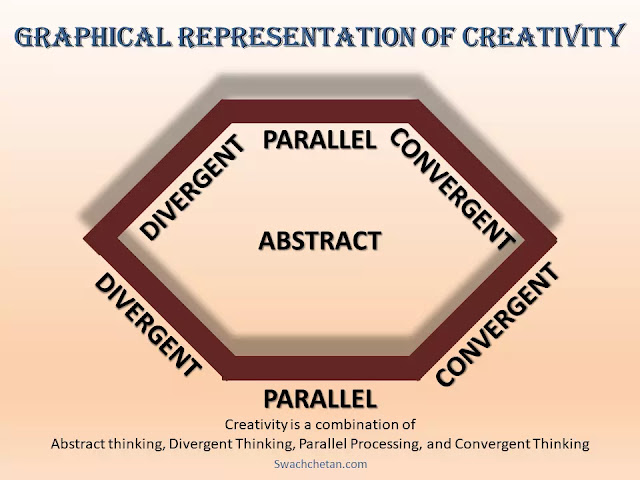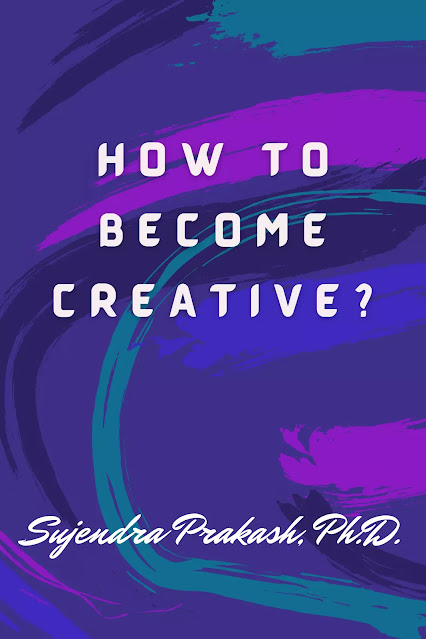Application of Creativity
Is Creativity just
imagination?
Creativity is
a mental faculty that involves creative thinking, creative decision-making, and
creative problem-solving. They are so interspersed in real life that only for
studying and understanding do we classify them separately.
As
imagination is also involved in fantasy and daydreaming, attributing
imagination to creativity is rather naïve. Instead of saying that creativity
comprises imagination, it is better to say that it includes abstract thinking. Abstract
thinking is more systematic than imagination and uses ideas and concepts in a
structured manner.
Creativity
is required only when there is a problem to solve or when something needs to be
produced anew. Without these objectives, it just becomes an act of imagination,
fantasy, or daydreaming.
Graphical Representation
of Creativity
The steps
present in creativity are depicted graphically in the diagram above.
Abstract thinking forms the basis of divergent thinking, parallel processing,
and convergent thinking leading to creativity.
Let us
clarify this with an example.
A painter collates
ideas as there is a need to produce new art on a fresco. S/he starts with
divergent thinking trying to fathom all kinds of possibilities for the shape to
take a form.
S/he then
uses parallel processing to see the possibilities of each line of ideas
generated through divergent thinking. After considering several permutations
and combinations, s/he decides to adopt one particular combination of color,
shape, design, etc.
However,
creative thinking is not over at this stage itself. While producing the art,
the painter encounters several problems and has to keep revising his/her
strategy and has to reformulate the thinking process. Changes are brought about
in all aspects of thinking.
During this
process, if s/he borrows ideas and concepts from either his/her own previous
experience or from other external sources, it becomes innovation.
Differences between Creativity
and Innovation
There is a
frame of reference for innovation whereas something new and original is thought
about in creativity.
Innovation
involves creativity and is a part of creativity. This is the reason why
innovative people are also referred to as creative.
In the
above diagram, the latter part of creativity involves innovation.
Brainstorming
is part of divergent thinking where you generate several ideas. Brainstorming
in itself is not creativity. It is only one of the processes involved in creativity.
To decide upon which idea works, you need to use parallel processing and
convergent thinking.
Let us
consider a few examples.
Someone who
produced fire for the first time by rubbing two stones or using two twigs is an
inventor. However, if you can use two stones or twigs to produce fire now, you
are creating something. The greatest highlight here is the fact that not
everyone can do that. Next, someone thinks of minimizing the effort and
increasing convenience and comes out with a match stick. This is innovation.
Using a
matchbox and a matchstick is not in any way either creative or innovative.
However, the users are encouraging creativity and innovation by accepting the
change.
Thus, innovation
involves trying, testing, adapting, accepting, and owning the product or
solution.
Benefits of Creativity
Not all
creativity results in success and not all creative people are famous. It all
depends upon the time and need. As children, we hoped there was a way to carry
the phone so that we were reachable all the time. At that time, it looked just
like a pipe dream but today it has become a reality, thanks to creativity and
innovation.
All
artists, designers, actors, cinematographers, directors, cooks, writers,
musicians, choreographers, goldsmiths, cobblers, photographers, farmers,
tailors, gardeners, carpenters, architects, software professionals, industrialists, business people, homemakers, etc. are creative
because they bring something new into the environment. And society benefits
from this creative output in some way or the other.
People in
other professions like engineers, doctors, accountants, lawyers, teachers,
scientists, pharmacists, journalists, laborers, police officers, defense
personnel, managers, economists, estate agents, etc. can also become creative
once in a while. However, these professions do not call for day-to-day
innovation as they are mainly guided by logical thinking. Only some of them use
their knowledge creatively when new solutions are necessary.
Dangers from Creativity
It is not always
that creativity is wonderful. Society has both positive and negative
characteristics. Creativity can also be used for destructive purposes. Thieves,
robbers, dacoits, confidence tricksters, drug dealers, bootleggers, adulterers, smugglers, black marketeers, money launderers, weapon manufacturers,
etc. are also creative but their jobs lead to losses in society.
Several
leaders all over the world have been using creativity to destroy climate, flora,
fauna, etc. for their benefit.
All professionals
listed above have chances to not only use creativity beneficially but also
destructively. This is the reason why creativity should be bound by moral
values so that the ability is not misused.
In short,
creativity involves several types of thinking. Some professionals use it
regularly whereas some others use it whenever there is a need for change. In
almost all professions, innovation is necessary because of the dynamic nature
of society.
This eBook is now Available in Leading International Digital Stores
Price: $4.99/- (Rs. 380/- approximately)
Or alternatively, you can buy the ebook directly from the author for Rs. 200/- only
Click here to order.
64 Nava Vidya or 64 New Skills














Extremely useful information which you have shared here about creative kids voucher This is a great way to enhance knowledge for us, and also beneficial for us. Thank you for sharing an article like this.
ReplyDeletePlease do not include any spam links in the comment box.